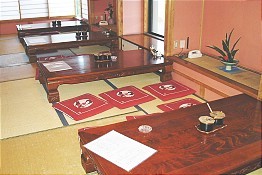Tables and sitting

A restaurant with traditional low tables
In Japan, some restaurants and private homes have low tables and cushions on the floor, rather than Western style chairs and tables. These are usually found on tatami floors. Please visit our information page about sitting techniques and rules for more information.

Itadakimasu and Gochisosama
In Japan, you say "itadakimasu" ("I gratefully receive") before eating, and "gochisosama (deshita)" ("Thank you for the meal") after finishing the meal.
Individual versus shared dishes
It is not uncommon in private households and in certain restaurants (e.g. izakaya) to share several dishes of food at the table rather than serving each person an individual dish. When eating from shared dishes, move some food from the shared plates onto your own with the opposite end of your chopsticks or with serving chopsticks that may be provided for that purpose.
Chopsticks
The proper usage of chopsticks is the most fundamental element of Japanese table manners, and therefore, we have assigned them a separate information page.
Some Table Rules
- Blowing your nose in public, and especially at the table, is considered bad manners.
- It is considered good manners to empty your dishes to the last grain of rice.
- Talking about toilet related and similarly unappetizing topics during or before a meal is not appreciated by most people.
- Unlike in some other parts of East Asia, it is considered bad manner to burp.
- After eating, try to move all your dishes back to the same position they were at the start of the meal. This includes replacing the lids on dishes and putting your chopsticks on the chopstick holder or back into their paper slip.
Drinking rules
When drinking alcoholic beverages, it is customary to serve each other, rather than pouring your own beverage. Periodically check your friends' cups and refill their drinks if their cups are getting empty. Likewise, if someone wants to serve you more alcohol, you should quickly empty your glass and hold it towards that person.
While it is considered bad manners to become obviously drunk in some formal restaurants, for example in restaurants that serve kaiseki ryori (Japanese haute cuisine), the same is not true for other types of restaurants such as izakaya, as long as you do not bother other guests.
Do not start drinking until everybody at the table is served and the glasses are raised for a drinking salute, which usually is "kampai". Avoid using "chin chin" when drinking a toast, since in Japanese this expression refers to the male genitals.
How to eat...
 | ... Rice:Hold the rice bowl in one hand and the chopsticks in the other. Lift the bowl towards your mouth while eating. Do not pour soya sauce over white, cooked rice. |
 | ... Sushi:Pour some soya sauce into the small dish provided. It is considered bad manners to waste soya sauce, so try not to pour more sauce than you will use. You do not need to add wasabi into the soya sauce, because the sushi pieces may already contain it, or may be eaten plain. However, if you choose to add wasabi, use only a small amount so as not to offend the sushi chef. If you do not like wasabi, you can request that none is added into your sushi. In general, you are supposed to eat a sushi piece in one bite. Attempts to separate a piece into two generally end in the destruction of the beautifully prepared sushi. Hands or chopsticks can be used to eat sushi. In case of nigiri-zushi, dip the piece into the soya sauce upside-down so that the fish enters the sauce. A few kinds of nigiri-zushi, for example, marinated pieces, should not be dipped into soya sauce.In case of gunkan-zushi, pour a small amount of soya sauce over the sushi piece rather than dipping it into the sauce. |
 | ... Sashimi:Pour some soya sauce into the small dish provided. Put some wasabi on the sashimi piece, but be careful not to use too much as this will overpower the taste of the fish. Dip the sashimi pieces into the soya sauce. Some types of sashimi are enjoyed with ground ginger rather than wasabi. |
 | ... Miso Soup:Drink the soup out of the bowl as if it were a cup, and fish out the solid food pieces with your chopsticks. |
 | ... Noodles:Using your chopsticks lead the noodles into your mouth. You may want to try to copy the slurping sound of people around you if you are dining in a noodle shop. Rather than being bad manners as Westerners are often taught, slurping noodles is considered evidence of enjoying the meal.In case of noodle soups, be careful of splashing the noodles back into the liquid. If a ceramic spoon is provided, use it to drink the soup, otherwise, lift the bowl to your mouth as if it were a cup. |
 | ... Kare Raisu: (and other dishes in which the rice is mixed with a sauce)Kare Raisu (Japanese style curry rice) and other rice dishes, in which the rice is mixed with a sauce (for example, some domburi dishes) may become difficult to eat with chopsticks. Large spoons are often provided for these dishes. |
 | ... Big pieces of food: (e.g. prawn tempura, tofu)Separate into bite sized pieces with your chopsticks (this takes some exercise), or just bite off a piece and put the rest back onto your plate. |
Tidak ada komentar:
Posting Komentar